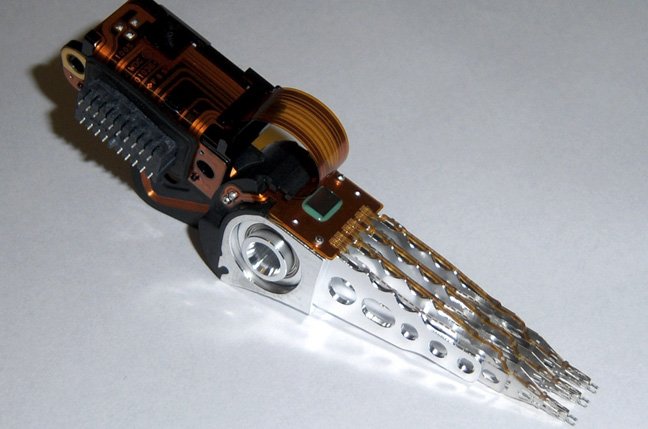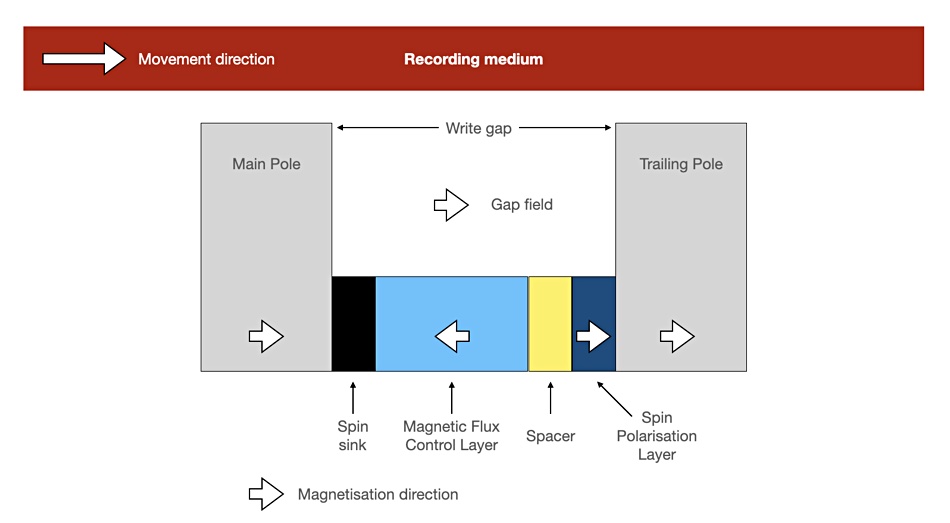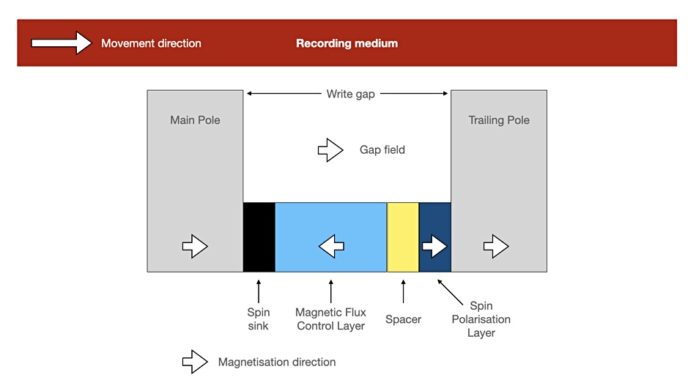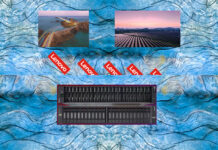Toshiba’s new MG09 disk drive uses Flux-Control Microwave-Assisted Magnetic Recording (FC-MAMR). What is a flux? How is it controlled? Why should you control it in a microwave environment?
A group of Toshiba researchers explains the concept in a paper published in the Journal of Applied Physics, titled ‘Magnetization dynamics of a flux control device fabricated in the write gap of a hard-disk-drive write head for high-density recording’.
The researchers write: “MAMR using the FC effect is promising for extending the recording density of HDDs.”
The write head part of a disk drive’s read-write head has a gap of 20nm or so between two parts or poles, which point towards the disk drive platter’s surface. There is a magnetic or recording field in the gap between them, which is used to write data by setting the magnetic direction of bits on the platter surface as they pass underneath the write head.

MAMR head
With MAMR, a Spin Torque Oscillator (STO) is placed in this gap to produce microwaves which radiate outwards towards the recording medium on the surface of the disk platter. They impinge upon a bit location on that medium, and act to lower its resistance (coercivity) to having its magnetic direction changed; a microwave-assisted magnetisation switching effect (MAS).
The Toshiba researchers applied a bias current, an initial direct current voltage, to the STO, to induce the magnetisation oscillation needed to produce a microwave magnetic field and cause the magnetisation switching effect. They found that the average magnetisation direction of the spin torque oscillation modified the recording field. This is called a flux control effect.
When the average magnetisation direction is parallel to but opposite in direction to the gap field, the flux control effect can strengthen the recording magnetic field. In this situation fewer microwaves are generated, so the actual microwave-induced magnetisation switching effect is lessened and the magnetic field strength is increased sufficiently through the flux control effect to write data to the drive.
The Toshiba researchers write: “The advantage of the flux control effect over the MAS effect is that improvement is obtained in any media regardless of the media properties because the flux control effect simply modifies the recording field.”
They note that disk recording density is likely to be larger with non-flux-controlled MAMR because the latter has a strengthened effect due to frequency matching between the STO oscillation and the ferromagnetic resonance of the recording medium’s magnetisation.
FC write head
The Toshiba researchers built a write head with a magnetic flux control layer (instead of an STO between the two poles). This was accompanied by a spin polarisation layer, with a spacer between these two components, and our diagram shows this:

There is a spin sink layer at the other end of the MFCL to block spin transfer torque at this interface. Normally, the magnetisation direction of the MFCL is the same as for the write head poles, gap field and spacer. When the bias current is applied the MFCL magnetisation direction is reversed (as shown in the diagram above).
This reversal weakens the magnetic flux inside the write gap but strengthens it outside that gap. The net effect is that the amplitude of the recording field is increased. That, in turn, means that the write performance of the flux control write head can be improved further than the limit of an ordinary write head.
The MFCL magnetisation reversal takes time but, even so, a flux control write head can operate at 2.86Gbit/s which is compatible with disk write speeds.
Read the Toshiba paper for more details.
Toshiba’s FC-MAMR appears to be similar to Western Digital’s ePMR (partial MAMR) recording technology as a bias current is used in both cases. The WD tech “applies an electrical current to the main pole of the write head throughout the write operation. This current generates an additional magnetic field which creates a preferred path for the magnetisation flip of media bits. This, in turn, produces a more consistent write signal, significantly reducing jitter.”
The Toshiba paper makes no mention of jitter. Like Western Digital and ePMR, Toshiba believes its FC-MAMR will likely be superseded by full MAMR to make even higher-capacity disk drives.








